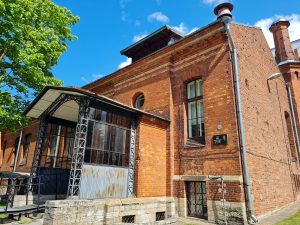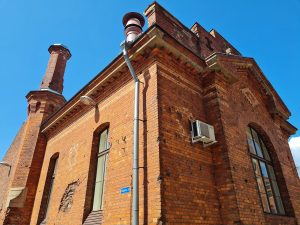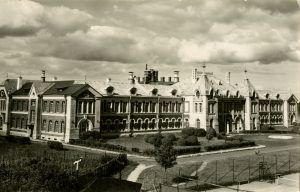Welcome to the territory of Narva Hospital, Estonia’s largest general hospital. In 1906, when the building was built, the Kreenholm maternity hospital was the most modern in Russia Empire and also in all of Estonia. Here there was hot tap water and water closets, of course there was electricity and ventilation in the building.
The hospital is a typical Neo-Gothic building made of red brick, which was produced in Kreenholm at the Kulgu brick factory. The powerful chimneys and the beautiful iron decorations deserve special attention.
Taking care of an employee’s health had a practical purpose back then. During the golden age of the factory there was an idea that a good worker is a healthy worker. Kreenholm grew and many children were born. It was innovative for the beginning of the 20th century to release women from work some time before they give birth and let them stay at home for a month with a pay after giving birth.
There were 30 beds in the maternity hospital. At first the female workers of Kreenholm did not seem to trust the maternity hospital, but a few years later 400 babies were born here every year. For the record, in 2022 only 270 children were born in Narva.
In the early days of Kreenholm, the older factory workers had a clear view that the factory literally saves a child’s life. A child had to be sent to work as early as possible. Although in 1882 the employment of children under the age of 12 was prohibited, and the working hours of children up to the age of 14 were limited to eight hours, child labor was still common in the early 20th century. Every tenth factory worker was a child.
Ants was 12 years old when he started working with his father in Kreenholm as a spinner’s assistant. The father himself had been recruited to the factory as an eight-year-old boy by the agent of its founder, Ludwig Knoop. Ants remembers how he first entered the workshop of Georgi factory: “They entered the machine room. The entire floor of the building was one giant room surrounded by four large walls, two of which were made up of full length windows. Under the ceiling there was a main shaft that was several dozen yards long, which was powered by the turbine shaft. Then the power was transmitted to the machines through the belts. The entire room was full of identical machines, standing silently but menacingly, instilling a kind of depression, awe, and fear. ///
My dad always came half an hour early. He didn’t let anyone else maintain his machine, but always did it himself, only himself. He considered it his duty to stand by the lever while the turbine shaft began to revolve, and at the same time, with one proud pull, set his machine in motion, which always worked flawlessly, without a single hitch. ///
Bobbins rolled on both sides, spinning on rollers that were several yards long. They moved smoothly, slowly, calmly as if threatening to squeeze you between them. But then both sides stopped as if on command and rolled back just as calmly and smoothly. Then they again ran together in the middle, dragging behind them several thousand thin threads, which floated like a wonderful white-surfaced sea or a white field of corn. Then the bobbins stopped again for a moment and thousands of spindles began to spin and wind the stretched threads upon themselves.”
This is what a future Communist commissar and shipbuilding engineer August Kimm wrote about his first work day in Kreenholm.







